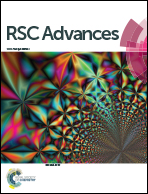Structural significance of modified nucleosides k2C and t6A present in the anticodon loop of tRNAIle
Abstract
The structural significance of the hypermodified nucleosides lysidine (k2C) and N6-(N-threonylcarbonyl) adenosine (t6A) present in the anticodon loop of E. coli tRNAIle has not been studied in detail theoretically at the atomic level. Hence, in the present paper, we investigated the conformational preferences of modified nucleosides k2C and t6A in the anticodon loop of tRNAIle using various quantum chemical methods. Multiple molecular dynamics simulation studies of the anticodon stem loop (ASL) of tRNAIle have also been made to see the solvation effect. The lysine moiety of lysidine orients back and forms a hydrogen bond with the 2′-hydroxyl group of the 34th ribose sugar whereas the t6A(37) side chain prefers a ‘distal’ conformation. This kind of conformation would be useful for recognition of the codons AUA instead of AUG. The t6A side chain prohibits canonical base pairing and maintains an anticodon open loop structure. The preferred conformations of k2C(34) and t6A(37) are stabilized by various intra as well as inter residual interactions within the anticodon loop which could be useful for maintaining a proper anticodon loop structure for smooth and in phase codon–anticodon interactions during the biosynthesis of proteins.


 Please wait while we load your content...
Please wait while we load your content...